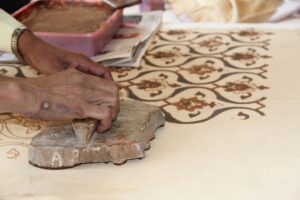Ajrakh as a craft was practiced along the banks of the River Indus now divided between India and Sindh, Pakistan.
Text and Photographs : Savitha Suri
Ajrakh is a combination of hand block printing and resist dyeing. The skilful use of two kinds of resist (mud and lime-resist) produces intricate, multi-layered designs on treated cotton cloth.
 Resist dyeing is a method of applying colours or patterns to fabric. A substance that is impervious to the dye, blocks its access to certain areas of the fabric, while other parts are free to take up the dye colour.
Resist dyeing is a method of applying colours or patterns to fabric. A substance that is impervious to the dye, blocks its access to certain areas of the fabric, while other parts are free to take up the dye colour.
The hallmark of the ‘original’ Ajrakh textile, which typically uses blue or red vegetable dyes, is double-sided printing, ( do-rukha) where the pattern on one side of the fabric is replicated, on the reverse side, with great precision.
In fact, the term Ajrakh itself may have been derived from the Arabic ‘Ajrak’, or colour blue.




Ajrakh as a craft was practiced along the banks of the River Indus (or Sindhu) now divided between India (Kutch in Gujarat, Marwar in Rajasthan) and Sindh, Pakistan.
Traders from Iran and Arabia who visited the Sindh region in the 7th Century were attracted to these bright and colourful textiles. In fact, the term Ajrakh itself may have been derived from the Arabic ‘Ajrak’, or colour blue.
Ajrakh textiles were used locally ( mainly for men’s clothes such a lungis, gamchas and turban cloths) as well as exported to various parts of the world including the Middle East.
 Traders from Iran and Arabia who visited the Sindh region in the 7th Century were attracted to these bright and colourful textiles. In fact, the term Ajrakh itself may have been derived from the Arabic ‘Ajrak’, or colour blue.
Traders from Iran and Arabia who visited the Sindh region in the 7th Century were attracted to these bright and colourful textiles. In fact, the term Ajrakh itself may have been derived from the Arabic ‘Ajrak’, or colour blue.
A typical feature of Ajrakh textiles is a large central body consisting of block printed motifs and multiple borders. To create these designs, fine cotton or silk cloth is hand block printed, step-by-step, on either side of the fabric.

Featured in the images are some of the steps of the block printing process. Workshop courtesy – Sarfraz Khatri. Location- CSMVS, Mumbai.
Different resists and mordants are applied to the fabric followed by submersion into dye baths of indigo and alizarin red. The dyeing process is often repeated twice to get deeper shades of blue and red. The entire process involves 13-15 steps, each requiring specific and precise skills.
Designs have evolved over time and have been influenced by preferences of the trading countries. The influence of Islam, especially Sufism, is prominent and many Ajrakh designs that are common and popular today are inspired by architectural motifs from the Islamic tradition.
